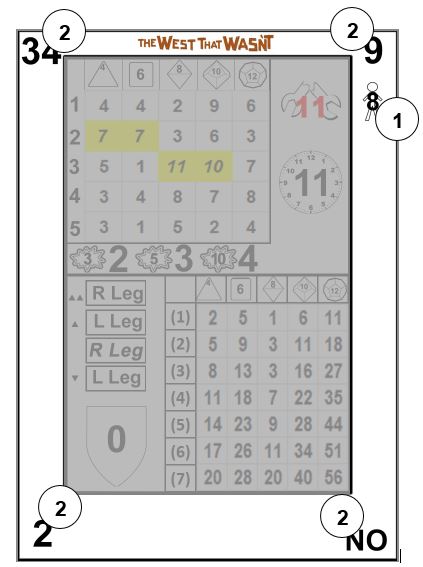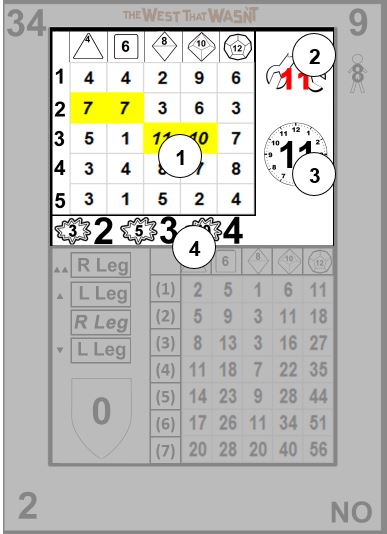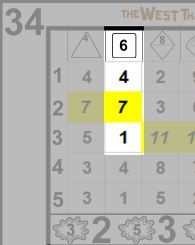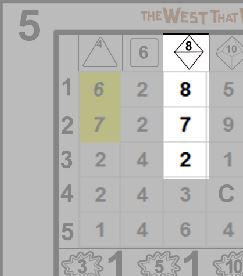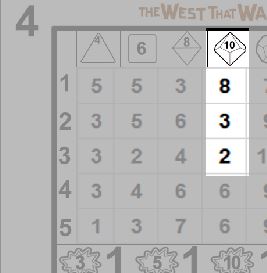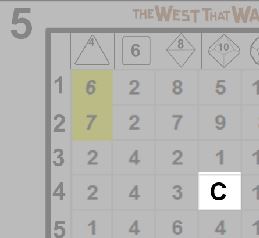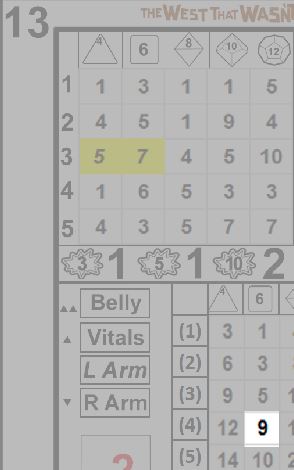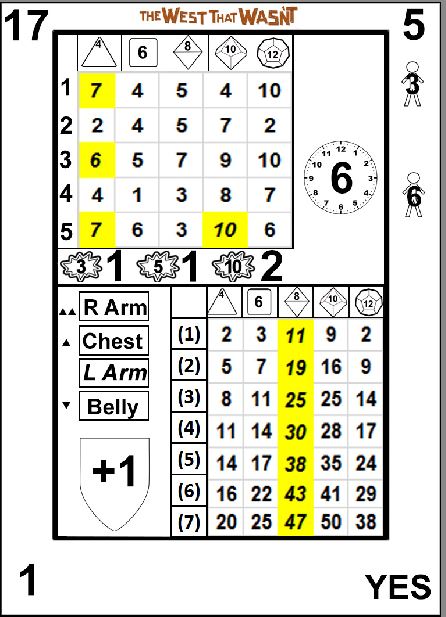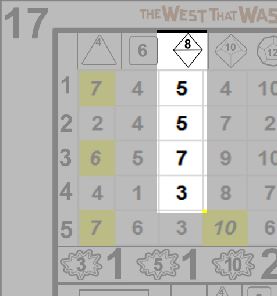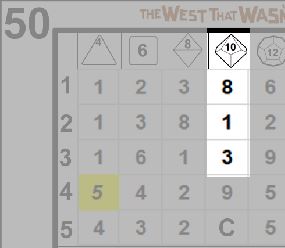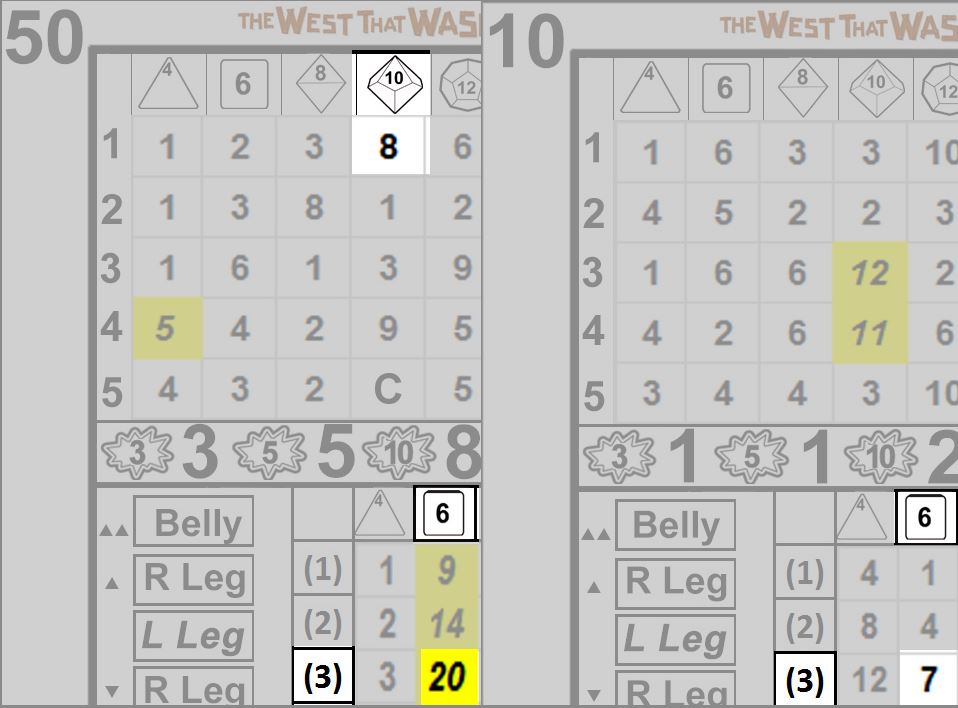Difference between revisions of "The West That Wasnt - Action Resolution"
m (→Complex Skill Checks, Example 1: Hank Sets Some Dynamite) |
m (→Accumulating and Generating Bumps) |
||
| Line 289: | Line 289: | ||
Unless noted otherwise in the appropriate rules section, any check in TWTW can generate bumps. Bumps are ephemeral, and must be used on the current check. They can never be saved for future use. | Unless noted otherwise in the appropriate rules section, any check in TWTW can generate bumps. Bumps are ephemeral, and must be used on the current check. They can never be saved for future use. | ||
| − | Bumps can be generated by checks that exceed the TN by a set amount, usually 4, but sometimes 3 with impetus (see the Crafting Stories chapter for more on Impetus). Bumps can also be granted based on edges or other character attributes. | + | '''Bumps can be generated by checks that exceed the TN by a set amount, usually 4, but sometimes 3 with impetus (see the Crafting Stories chapter for more on Impetus).''' ''(The impetus rules have changed and this item may need to be removed)'' Bumps can also be granted based on edges or other character attributes. |
===The Bonus Counter=== | ===The Bonus Counter=== | ||
Revision as of 08:19, 5 April 2020
Stories, and games, happen because characters do things. Not just everyday, mundane things, but exciting, dangerous, interesting things. The things characters do in a game are represented by Actions. The mechanical resolution of an action is a Check (simple or complex).
Contents
Actions
In the real world, as well as in great fiction (and games), some things are pretty simple, while others are more complicated undertakings. To this end, The West That Wasnt provides two resolution types to be used as necessary to simulate the game world. Simple situations, like loading a .45 caliber shell or climbing a cliff face (simple from a success or failure point of view, not necessarily simple to do), are simple checks. For more complicated endeavors, where multiple external or personal factors could be at play, the complex check system is here to help you bring these situations to life.
Simple Checks
Simple checks include any action that produces a single, binary result (such as pass/fail, hit/miss, etc.). Simple checks are straight-forward actions in the abstract. They may not be simple in action, but the outcome is a binary result (critical failures - see below - are still potentially possible), and there is no gradation of success. After the check is described, the Judge assigns a Target Number (TN) and the action is resolved. If the result meets or exceeds the TN, the check is successful. That is it.
Hank Daggett wishes to reload his shotgun using his speed load skill so that he still has an action to blast the bandit accosting him straight to tarnation. The possible results are: he succeeds in reloading the gun with his action remaining (a success); he successfully reloads, but it takes his action (a failure). The results are binary, this is a simple check. A critical failure can also occur, causing no shell to be loaded and possible for it to be dropped or lost, but this is still a simple check because there is no variability in success.
Complex Checks
Complex checks are the foundation of exciting scenes. When a Hero needs to do something great, likely that is a complex check. In most cases checks are much more than a binary result. There are potential complications, deviations and unintended results. By utilizing the complex check system one card is drawn to resolve a series of events.
Complex checks involve both success and magnitude. They may also persist from one action round to the next. To achieve this, complex checks have both a TN for successful progress, but also some number of victories for completion.
After declaring your action to the Judge, they may inform you that it is a complex check. The Judge will provide both a TN as well as a number of victories necessary to complete the check.
Results and Effect
If a complex check generates a value equal to or greater than the given TN, there is some measure of success. To see how much, check the effects section of the Action Card. For each multiple of the victory threshold, 6 (see below for optional rules on adjusting the victory threshold), in the magnitude, one victory is generated. Partial victories are not possible, any amount above a multiple of the victory threshold is truncated.
All necessary successes need not be accrued in a single action, and multiple characters may collaborate to produce greater effect (see cooperation XX) or more victories.
Hank Daggett wishes to prepare a dynamite device as quickly as possible, so he can evacuate the premises. The Judge informs him this will be a TN 7 Dexterity and Demolitions check, with 3 victories required. He flips his card and generates an 8. This is a success, but no bump. Referencing the effect grid, he finds a 13. Two victories are generated, leaving one more necessary. He is partially done, but will need at least one more action (or help) to complete the device.
Unskilled Checks
There comes a time in the life of a Hero where something just has to be done, and yet, the Hero has never done it before. In TWTW, a Hero can attempt any task the player can devise, but without the appropriate skill, success is much less likely.
When attempting a task where the Hero lacks the appropriate skill, the leftmost (d4) column is used. The row is equal to the rank of the associated Trait.
Miranda Valentine is covering Hank while he sets an explosive charge. Before he can complete the task, Felicia Laroq uses her whip to grab him by the ankle, and pull him down from the ledge. Everything in Miranda says to draw her trusty irons and handle Felicia now. while she is vulnerable, but she knows they only have one chance to set the dynamite. Miranda has never worked with explosives, so she will use the d4 column. The associated Trait is Knowledge, where her training is a measly 1. She will draw an Action ard and consult the 1d4 cell. This could get ugly...
Resolving Checks
In TWTW, checks of all types are resolved using action cards. The cards are designed for fast, yet detailed, resolution to checks. Keep the game moving, keep the action foremost and let the players play. The mechanics stay out of the way, facilitating a fast paced game.
Setting Difficulty
| Check Difficulty | TN | |
| Easy | 3 | |
| Standard | 5 | |
| Challenging | 7 | |
| Difficult | 9 | |
| Incredible | 11 |
Just as Miranda's father dies, he whispers a plea into her ear. He wants her to go to Dodge City and protect his long lost nephew, an accused prisoner, from a date with the hangman. Miranda is a Hero; of course she will set off for Dodge.
The Judge asks for a Standard area knowledge check to know the location. Since this is a standard difficulty, the TN is 5. She flips a card for results of 3, 7 and 8. Success! The journey to Kansas is ready to begin.
Using Action Cards
Action cards are at the heart of The West That Wasnt. Whenever success is in doubt, action cards will help you determine the result. In this section action card usage will be explained in a step by step manner. For further information about card anatomy, card creation or alternative card usages, see The West That Wasnt: Appendix - 1, Action Cards.
This chapter is intended to provide an overview of how to use the action cards. It is not intended as a full rules explanation. Some elements of the rules need to be explained to provide the necessary context for understanding card usage, but it is in no way complete. Please reference the appropriate rulebook chapters for comprehensive rules explanations.
Reading Cards
The Action Cards included with the game are loaded with data. The sheer volume of information may seem daunting at first, yet once their usage is mastered they become simple and quick to utilize. Note that even in the most detailed of actions only a subset of the information contained will be referenced. In most cases only one or two sections will be necessary.
To learn how to read a card, begin by drawing one and examining the card face.
Consider the entry in the upper left corner of the card, only. Do not let the information density overwhelm you at first glance. The cards have enough entries to resolve any kind of action, in any situation. But in any given action, only a small subset of the results will be consulted. To avoid information overload, concentrate only on the entries needed for the action you are currently resolving. This step by step guide will show you how to use each section in turn, and provide concrete examples to bring the knowledge together into a useful form.
Action card concept 1: Use what you need, ignore everything else.
The example card is number 34. When cards are referenced, the large number in the upper left is the unique identifying number. Anytime the rulebook refers to a card, it will reference this number. These numbers range from 0-53, as discussed here.
Each card is divided into three sections,
the outer edge, containing the following information:
1. Unintended targets (ancillary effects, below)
2. Corner results (appendix).
The upper results, containing:
1. Cause grid (next section, skill checks)
2. Equipment Failure (ancillary effects, below)
3. Scatter (ancillary effects, below)
4. Burst results (combat, below)
And the lower results, consisting of:
1. Effect grid (complex skill checks, below)
2. Hit locations (combat, below).
3. Armor penetration (combat, below).
Nomenclature
When speaking of a single given cell in the cause grid, the convention is row-column, such as 3-8, for the d8 cell that has an 11 result (third row, above). When speaking of a result set, where multiple dice of a given type are rolled, the standard RPG convention of [row]d[column] is used, so for 3d8, the results of 2, 3 and 11 would be included (again, using the above image). In the effect grid the convention is the same, except the row labels are enclosed in parentheses, so the 4th entry in the d8 column is (4)8.
Now that you are oriented and informed on card notation, the first step is learning the simplest task, a basic skill check.
Performing Skill and Attribute Checks
Roleplaying games are predicated on characters doing interesting things. Many times, those things may fail. When success is not guaranteed, action cards are used to determine the outcome. The process is detailed below.
The Cause Grid: Simple Skill Checks
Skill checks can be performed using only a single result from the card. In the upper section of the card is a 5x5 grid, with rows numbered from 1-5, and columns with 4, 6, 8, 10 and 12, along with symbols matching the shape of dice with the given number of sides.
Do not worry, dice never need to be rolled in conjunction with action cards.
Then why are the dice symbols present? As a player of roleplaying games, you are likely familiar with polyhedral dice. If this is your first roleplaying game, you may have seen the 6 sided cube that is used in table games such as craps to board and roleplaying games like Monopoly and Dungeons & Dragons as well. The dice symbols help to set expectations for players on what results are likely to occur in a given column*. The 6 column, for example, acts like the standard six sided cube. Most results in the 6 column will fall within the range of 1-6, while the results in the 10 column will fall mostly from 1-10. A full explanation for how the results are distributed is available in the appendix.
Simple skill checks use only the cause grid. This means, according to Concept 1, everything else on the card should be ignored. All you need is a number of rows equal to the skill level of the skill being used and a column representing the die type of the appropriate trait (illustrated below).
Each row is an additional die of the appropriate type. When a skill level is greater than one, the player resolving the action may choose any result from a row equal to or less than the level of the skill, in the appropriate column based on the governing trait. The only exception to this is calamities, discussed in the special section below. For example, if Hank Daggett has an Essence of d6, and a Bravery of 3, he may choose either 4, 7 (why is this result highlighted? See exceptional results, below) or 1 (assuming card 34, above, as the card drawn).
Skill checks are that simple. Draw a card, cross-reference the die type of the appropriate trait with the skill level of the skill being used, and choose the result. In general, the highest result present will be chosen, though there may be reasons why another result is selected. Except in the case of calamities the active player (the one that drew the card and is resolving the check) may always choose which result to use.
Attribute checks are performed exactly like skill checks, except the attribute level is used in place of skill level.
After completing the check, place the card in the discard pile. Even though only a small amount of the information on the card was used, each card is utilized for a single action only. In the case of a simple skill check, between 1-5 rows in a single column will be consulted, nothing more.
*You may notice a 7 in cell 2-6, and an 11 in 3-8. The results are open ended, discussed in exceptional results, below (immediately after the following examples). For more on how the results are generated and distributed, see the appendix.
Further Examples
Miranda Valentine is posing as a lady of the evening in a local brothel; an activity she detests. While maintaining cover and dodging customers she injures her arm in a fall. She attempts to use Streetwise to locate a local doc.
The Judge declares a TN of 7, and she has a skill of 3d8.
Success!
Cyril Wellington enters a high stakes gambling event in Tombstone. Certain of his ability, he enters a card game he has never played.
"No problem, Im an accomplished gambler. Cards is cards."
He has 3d10 in gambling. The opponents are skilled players, which normally sets the TN at 7, but because he does not even know the rules the Judge increases the TN to 9.
Uh oh, an 8 will not do it. Noticing his table cash getting uncomfortably low, Cyril looks for a way out. The pit boss and bouncer have other ideas.
Exceptional Results
Great stories are filled with instances of characters performing extraordinary actions. The West That Wasnt seeks to simulate this with extraordinary results. Previously, it was mentioned that most results will be less than or equal to the number atop the column. In some cases, results that are equal to or greater than that number will be shaded in yellow, bold and italicized*. These are exceptional results.
Exceptional results allow results to be open ended. When one of the cells in the result set meet the criteria above, immediately draw another card and add the value from the corresponding cell to the previous result. If another exceptional result is drawn, repeat the procedure until a standard result is drawn. Only the necessary cells are used, everything else on these additionally drawn cards is ignored, so they may be immediately discarded after combining the results.
Unlike standard skill checks, exceptional results use the exact cell only, other results may not be selected. In other words if the exceptional result is in 2-10 (as in 34, above), then only the 2-10 result in the next (and subsequent) card(s) may be chosen. If multiple cells within the result set display exceptional results, either may be selected after drawing the new card, but the same rules apply. See example 3, below, for more on this possibility.
Exceptional results are optional.
*See the Appendix for the rationale behind the symbology.
Exceptional Results, Example 1: Hank Skedaddles
Hank Daggett is attempting to elude 3 vaqueros from the Laroq hacienda who wish to question him about why he was hanging around their gold mine. Having sprinted from the mineshaft, he is looking for the fastest route to anywhere but here. With the cowboys hot on his trail, he knows that his situation is desperate so he decides to attempt something truly crazy. He runs along the mountainside and leaps out, attempting to land on the top of a passing stagecoach.
The Judge declares this to be an incredibly difficult task, and assigns a TN of 11. Hank quips, "Aw hell," and draws a card.
Hank has a Strength of 2d10, and this is applicable because he is leaping for distance. Consulting the card drawn, 14, he finds 9 and 12, the latter denoting an exceptional result. "Aces!", says Hank, and he draws another card, 5. Cross referencing the 2-10 result he finds a 9, making his total 21.
"Be seein' ya!" Hank grabs the roof, looks back at the hombres, smiles and winks. "Too-da-loo, gents."
Note: If optional rules for bumps were used, he would have achieved 2. See the section on bumps, below.
Exceptional Results, Example 2: Cyril Saves the Day
Back on the prairie, Cyril spies Hank through his field glasses, just in time to see him leaping onto the moving coach. "Unbelievable," he thinks to himself. "Those vaqueros know Hank, and that he works with both Miranda and me," he thinks to himself. Quickly, he hatches a plan.
The cowboys are raising the alarm, so security is extra vigilant, but no other choice makes sense. Cyril declares he will sneak in and detonate the TNT Hank just placed. The Judge declares the TN a near-impossible 13. The card: 34.
He may be a city slicker, but he has 4d10 in Stealth. Glancing over the results, he is pleased to find 9, 6, 10, and 7, including an exceptional result. "This just might work", he thinks and draws another card, 6. Fortuitously, another exceptional result! Drawing again, he reveals the 5 card. Adding the results gives a 21. Smoothly, and without making a scene, Cyril slips past the guards just as they assemble.
Note that even though Cyril has a 4d10 in Stealth, he cannot choose the 9 result on the 5 card, because only the 3-10 cell can be used in this draw. Also, even though the 4-10 result in card 5 is C, and his skill is 4d10, this does not cause a critical failure. Critical failures can only occur on the card drawn to resolve the action, the additional cards drawn for the exceptional result are optional, and only serve to extend the initial card. This also explains why only the 3-10 cell is relevant, in effect only that "die" is rolled, no further action is attempted.
Finally, if the optional bump rules (see below) were being used, Cyril would have generated 2 bumps.
Exceptional Results, Example 3: Miranda Delivers
Finding herself thigh-deep in muck while waiting for Hank to blow the mineshaft, Miranda has certainly had better days. It just gets worse when her Sharps malfunctions while she is trying to pick off a horseman gaining on Hank, astride a speeding coach. Knowing she has little time, because the horseman is gaining rapidly, she begins trying to restore her trusty long arm.
The Judge declares the TN 5, since it is a relatively normal weapon malfunction. The issue is Miranda does not know the cause of the breakdown, so she will need to troubleshoot the issue. She is very skilled with rifles, having 3 dice, however her Knowledge is only d4. Normally with the Sharps she is shooting trouble, with Dexterity, not troubleshooting, with Knowledge.
Having no other option, she draws.
Hmm, not bad. Card 7 has two exceptional results! Drawing another, she spies the two corresponding cells and chooses a result of 10 (7+2 vs 6+4). Success (and a bump, if those rules are used).
Calamities
As with exceptional successes, entertaining stories often include spectacular failures. At times even the most skilled individual encounters a set of circumstances that cannot be resolved satisfactorily. Calamities are results that lead to failure no matter the situation, and often can lead to the most dramatic result possible. Adjudicating calamities is covered in section, this paragraph is solely concerned with how to read the results on the action card.
In most checks, the player can select any result in the appropriate column up to and including the row of the skill level being utilized. The exception to this is when the exact row/column combination yields a C result. Note that it does not matter if a C is in any other location on the card, a critical fail only occurs if the exact box directed by the attribute/skill combination on the resolution card* contains C.
In the given card image below, if Angus Laroq has a 4d12 Strength, and is attempting to lift a fallen tree trunk, the result is a calamity. In the event of a calamity the Judge determines a result appropriate to the situation at hand, however any member of the Crew, including the player resolving the card, may make suggestions.
For all other purposes, a C result counts as a 0.
*In TWTW, all actions can be resolved by a single card draw. This card is called the resolution card. Some optional effects, such as exceptional results, can trigger further draws. These draws extend the result on the resolution card, and are never counted for calamities in any way.
Complex Skill Checks: More Than a Binary Result
In some cases, an action requires more than a pass or fail. These actions are called complex skill checks. This type of check generates a binary pass/fail, and if successful, a magnitude defining how successful the action was.
Complex skill checks take simple skill checks one step further, and use two sections of the card: the cause grid (like simple skill checks) and the effect grid. These types of checks could be due to extended actions, where success is achieved over time (such as digging a well), contests (where two characters compete at a task), actions involving a magnitude rather than a binary success (such as throwing an item for distance), combat actions, or other possibilities as defined by the Judge.
Referencing Action Card Concept 1, use the cause grid and effect grid, and ignore everything else. As with simple skill checks, the cause grid is used to determine whether an action is a success. The effect grid is used to determine the magnitude, if necessary. Without a success, no magnitude is generated. An action card is discarded after one resolution (successful or not).
Using the Effect Grid
Unlike the cause grid, the results in the effect grid are always arranged in order of increasing value as the row increases. The rationale for the arrangement of values in the grids is covered in the appendix. Because of this, the cell corresponding to the appropriate row and column is always chosen.
Generating Victories
The value in the given cell is the magnitude of the action, but this by itself does not provide all of the information needed. Victory has a target of 6. This means that for each multiple of 6* in the magnitude, one victory is generated. For example, in the 13 card (below), the (4)6 effect grid result would generate one victory, because the magnitude is 9. Unless specified otherwise, any amount over the target is lost, in this case, 3.
When performing a complex action that requires multiple victories, the Judge will inform the player of the required number of victories before they make their attempt.
*See the appendix for more on the target victory magnitude of 6.
Complex Skill Checks, Example 1: Hank Sets Some Dynamite
After spending the night sneaking past the hacienda to the hidden mine shaft, Hank has calculated that the best place for the explosives to bury the shaft is a nook a few paces into the cave mouth. He knows the cave is protected by a slug of hombres, so his only hope of gaining access and placing the TNT is through a different tunnel.
Having entered the nook, he assesses the structure and determines that he needs to place 3 separate bunches of dynamite, and connect them all in series. Just then, he hears the wheels of the cart scraping the track, and two voices approaching. The Judge informs him that it will require 5 victories to set the device. The Judge sets the TN to 7. He draws the following card:
Hank has 4d8 in Demolitions, and he is using top quality sticks and caps from his mining days, (3)10 quality. Consulting the card, he finds success (5, 5, 7, 3 vs TN 7).
Excellent. Now to determine how much progress is made this round.
The quality of the equipment, (3)10, is used to generate the effect. With the standard effect threshold of 6, the 25 magnitude generates four victories. Note that unlike reading the cause grid, in the effect grid only the exact cell referenced is necessary.
One more to go, Hank knows he needs to step up his game if he is to set the explosives quickly enough to be able to escape the approaching miners as well. The ornery cuss just might do himself proud.
Complex Skill Checks, Example 2: Cyril Knows
Having blown the mine, Miranda and Cyril find their way to the edge of the Laroq hacienda, driving their horses hard for a getaway. Incredibly, the drawbridge is up, and the mechanism is fixed with a series of locks! The Miners and vaqueros from the mining operation are fast approaching, and out for blood. Miranda says she can hold them at bay for a few minutes, but he needs to hurry. Cyril gets to work.
Once he dismounts, he can see how the locks are holding the bridge up. It is quite complicated, but he is well-educated, especially for the west. Sometimes it pays to be a city slicker.
The Judge declares this a TN 7, with 6 victories required. He has a strong Lockpicking skill, 3d10, but only rudimentary tools, (3)6.
He gets an 8. Progress. But how much?
Just what the doctor ordered, an exceptional success! His total of 27 scores 4 victories right out of the gate. "Great news, M-V, I saw something just like this once back in Brooklyn!"
Applying Bonuses and Penalties
In The West That Wasnt, many things can happen. The Judge has great freedom in applying appropriate bonuses and penalties to actions to help simulate the environment and situation. There are two guidelines that should always be followed: be sure the adjustments are clear to the players before cards are drawn, and do not apply adjustments in ways that contradict the design of the cards themselves.
The first guideline is fairly clear and obvious. There may be a time when obfuscation of an adjustment is necessary, but generally the guideline is easy to understand and implement. Only violate it if you know what you are doing and you are attempting to achieve a particular story effect.
The second guideline requires some explanation. How can the card design be contradicted? The results in the cause grid are randomized and arranged differently than those in the effect grid. Because of this, they should be treated differently.
There are three types of possible adjustments: direct, row and column. A direct adjustment is one that adds or subtracts a modifier to the result in the cell. A row adjustment changes the row value, while a column adjustment alters the column value. Understanding the grid designs helps clarify how to properly utilize each kind of adjustment.
Direct adjustments are simple and affect both grids identically. In all cases direct adjustments may be applied to either grid. If a direct adjustment takes a result to 0 or less, the result is 1 if it is a cause, 0 if it is effect. Direct adjustments can never create calamities. Only the calamity result can cause a calamity, unless specifically directed by another rule.
Row adjustments are only slightly more complicated than direct adjustments. For cause grid results, a row adjustment changes which results may be chosen. For effect grid results, the adjustment alters which value is chosen. Both grids are designed to handle row adjustments without special modification. Follow the normal rules for consulting the appropriate grid after applying the adjustment. A row adjustment just changes the size of the "dice" pool.
Column adjustments require special rules. Column adjustments essentially change the number of "die type". Very few rules use column adjustments, and it is recommended that the Judge apply column adjustments with great care. The following suggested rules govern column adjustments:
1. Never apply column adjustments to cause grid results.
2. When applying negative column adjustments to effect grid results, such as with reduced damage in the penetration rules, keep the intent of the mechanic in mind. Reduced damage should always be less than normal damage. Therefore, if the column is shifted left (the "die type" is decremented) the value in the new result must be less than the original result. This includes increased effect.
Miranda Valentine is attempting to blast Felicia LaRoq with her Peacemaker. Felicia is in partial cover, with the left half of her body behind the corner of the North Star Saloon. Miranda draws card 39:
The hit location shows left arm, so her Peacemaker deals reduced damage because of the wall. The original damage result (3d6) is 18. The reduced damage result is 11, but with increased effect. When she draws her second card to add to the damage, any number greater than 6 will be treated as a 6 so the the reduced damage result is less than the normal damage of 18. Even if she were to draw card 45, which also shows an increased effect, the final value is still limited to 17.
3. When applying positive column adjustments (shifting to the right; increasing "die type"), the new value must be greater than the previous value, and, additionally, if increased effect was generated in the original result, the adjusted result also is treated as having increased effect even if the card does not have increased effect in the given column.
Smarting from her wounded left arm, Felicia screams commands to Octavio, one of her vaquero henchmen. Octavio hurls his lasso at Miranda, attempting to snare her Peacemaker and disarm her. He was completely hidden, and Miranda is surprised. Octavio also has an advantage which the Judge rules gives him a positive column shift. His skill is 2d8. He draws card 17:
The result in 2d8 is 19 with increased effect, however with the column shift the 2d10 result is only 16. Because his initial result has increased effect, the Judge draws another card for Octavio. His final result will be at least 20, if a 3 or less is in the new result, a 4 will be used instead so the total result is greater than the initial result. That is very helpful, because he needs at least 2 bumps to change the hit location from left arm, to right arm, where the Peacemaker is...
Escalating Success: Bumps
Heroes are achievers. During any check, when the TN is exceeded by 4, another success level is generated. This is called a "bump". Bumps are in-game currency the player can use to tailor the results to the situation at hand to enrich the story.
Accumulating and Generating Bumps
Unless noted otherwise in the appropriate rules section, any check in TWTW can generate bumps. Bumps are ephemeral, and must be used on the current check. They can never be saved for future use.
Bumps can be generated by checks that exceed the TN by a set amount, usually 4, but sometimes 3 with impetus (see the Crafting Stories chapter for more on Impetus). (The impetus rules have changed and this item may need to be removed) Bumps can also be granted based on edges or other character attributes.
The Bonus Counter
At the beginning of each session the Judge will provide a bonus pool, which generally consists of a number of bonus counters equal to one less than the number of players. These counters are shared by the group. Players may earn or spend them as the game progresses. The following rules govern bonus counters.
1. No player may ever hold more than one bonus counter at any time.
2. Spent bonus counters are immediately placed back in the pool, and are available to be earned.
3. Unspent bonus counters are lost at the end of any session of play.
Spending the Counter
Bonus counters can be spent in a number of ways. Usually, the counter is spent on values in the effect grid. A bonus counter generally has a value of +2, but can be worth up to +3 in some situations involving impetus.
Right on! This spend adds +2 to a value in the cause grid. This spend can only be used to increase the number of bumps. It can never change a failure into a success. This is the only legal spend on the cause grid.
Aces! This spend adds +2 to an effect grid result.
As I planned! This spend adds +3 to an effect grid result. The player must be invoking an Impetus on this action.
I've got your back! This spend is special. Instead of taking an action, the player declares how they are helping another player achieve their action better. The bonus counter may be spent by the target player. The target player may not be already holding a bonus counter, unless it is also spent on this action. Multiple players may perform the same action simultaneously. This spend costs 1 AP, or 0 at Judges discretion.
Why a Bonus Counter?
The bonus counter is a mechanic that is uncommon, at best. Why does TWTW choose to have such a thing? Part of what the bonus counter does is to mitigate the disappointment of getting a great result on something that wastes all the extra bonus. Its frustrating to generate a bunch of bumps when they have no further affect on gameplay. By having the counter, a player can "save" a bump from one roll and use it later, when it counts. Notice how the bonus counter never changes failure into success. Failure is important, or, rather, the risk of failure is. Heroes need to face adversity.
In the end, the purpose of the counter is the same purpose as any other rule in the game: to enhance the experience. In TWTW there are no mechanics to prevent nastiness from occurring to the heroes. The designers have stayed away from narrative currency on purpose. At the very least, something such as the bonus counter helps the heroes use the great results they generate.

